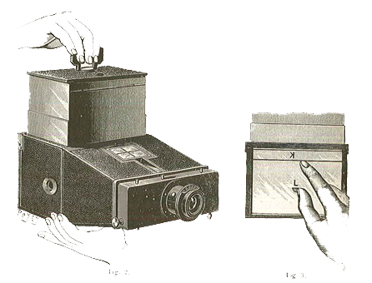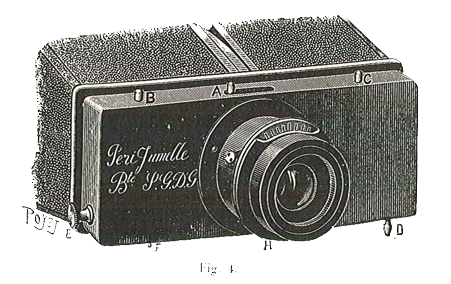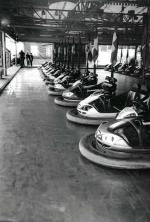|
Irumberry Peri-jumelle |
Manufactured or assembled in France from (Before) 1898 to (After) 1902.
Index of rarity in France: Rare (among non-specialized garage sales)
Inventory number: 2074
See the complete technical specifications
Chronology of cameras Irumberry

According to the 1898 Annuaire de la photographie.
Description and Advantages
The camera known as the "Jumelle" is undoubtedly one of the most practical ever created. Compact and equipped with a supply of plates, the Jumelle is the ideal camera when it functions properly. Most of the similar cameras built until now have serious flaws that make their use uncertain.
Recognizing the numerous shortcomings of these cameras, we sought to eliminate them and create a Jumelle model that is extremely practical and completely reliable. Our primary effort was to regularize the plate escamotage, prevent the irregular fall of the frames, and eliminate any causes of veiling, accidents that occur too frequently with the Jumelles and detectives currently on the market.
Starting from the principle that automatic plate changing must, to be perfect, be executed in the same way as if it were done manually, we have created a special mechanism that replicates all the movements that an operator's hand would make. This completely new mechanism consists of two double connecting rods that act on two gutters used to grip and convey the plate. This camera operates smoothly and regularly, and with it, we no longer have to worry about a plate falling out of place, temporarily disabling the camera. Unlike what is done with almost all similar cameras, we move the exposed plate from the front to the rear without having to move the other plates.
In this operation, the exposed plate does not fall into the void; it slides behind the others without a sudden drop, and therefore, without the risk of breaking.
OPERATING INSTRUCTIONS
 LOADING THE CAMERA
LOADING THE CAMERA
Remove the rear cover by pressing on the small spring that holds it and pushing it upwards; it slides like the cover of an ordinary negative frame.
Grasp the magazine by the handle and pull it vertically all the way out (Fig. 2).
Open the inner metal cover by pressing the bottom part in L, which allows you to push the upper part K forming a cover upwards (Fig. 3).
Load plates into the metal frames, ensuring that the upper magazine is pulled all the way out, keep it there, and reintegrate the metal frames into the magazine one by one in numerical order, with the two small notches notched in the plate holder turned upwards.
Make sure the counter is set to number 48.
Close the magazine and replace the sliding cover.
The camera is now ready to operate.
FOCUSING
The Zeiss lens mounted on the camera will provide sharp images from eight meters and beyond when set to infinity, which means at the last graduated division. For cases where it will be necessary to photograph a closer object, set the focus at the desired distance engraved on the arc by aligning the reference mark with the required distance number.
In this case, only the point to be photographed will be sharp.
PLATE INSERTION
The object to be reproduced is viewed using the clear viewfinder embedded on the top of the camera (Fig. 1). First, lift the viewfinder and take care, while aiming, to align the point of focus with the intersection of the two lines drawn on the viewfinder glass; to close the viewfinder, lower the point of focus first and fold the viewfinder over it.
 SHUTTER (Fig. 4).
SHUTTER (Fig. 4).
Extra-fast, with variable speed and for time exposure, opens and closes without any vibration. To operate it, push the button A from right to left, which arms the shutter without exposing the plate; the shutter release for instantaneous exposure is achieved with a gentle pressure on button B. For time exposure, use a prolonged pressure on button C or use the bulb (D); as soon as the finger leaves the button or the pressure on the bulb is released, the shutter closes. So, you can practically take posed instant photos. The speed moderator is located at E, with different graduations indicated by a slider at F.
Use the large apertures for instantaneous shots and the smaller ones for time exposures.
The lens has Iris diaphragms controlled by the wheel II located at the front of the lens. The aperture settings are engraved, and a reference mark allows you to use the desired one.
PLATE ESCAMOTAGE
Hold the camera horizontally with your left hand (see Fig. 2), pull the lever on the camera with your right hand, turn this lever from left to right to move the exposed plate backward, allow the lever to return to its original position, and push the drawer back into the camera. Given the robustness of the various parts of the PÉRI-JUMELLE, there is no need to fear executing these movements firmly and vigorously. Each movement of the lever corresponds to the fall of a plate and moves a counter that records all the escamotaged plates. A simple glance at this counter allows you to know how many plates have been exposed.
The camera also functions well with its unloaded frames.
The PÉRI-JUMELLE is equipped with two Congress screw threads, allowing it to be mounted on a tripod for time-exposure photography and to operate either in height or width.
What characterizes the PÉRI-JUMELLE is its new escamotage system, ease of use, operational safety, and robustness.
Achieving regular escamotage would be insufficient if precautions were not taken to ensure that this operation is carried out away from any light infiltration. The system we have chosen is completely effective against veiling. The plates are enclosed in a double metal drawer that absolutely prevents any light from entering the interior of the camera.
The numerous improvements made in the PÉRI-JUMELLE, the absolutely careful manufacturing of its various parts, now allow us to offer amateurs a perfect photographic Jumelle, with which they will not have to fear any of the failures and accidents that are often attributed to similar cameras.
The PÉRI-JUMELLE is manufactured in two sizes: 6 1/2x9, containing 18 plates, and 9x12, containing 12 plates, a sufficient supply for an excursion, even if it is of long duration.
The pictures obtained with this camera are of great finesse; they lend themselves very well to direct viewing, enlargement, or slide preparation. Despite its very compact and lightweight format, it is very sturdy; therefore, it is the ideal cameras for tourists (cyclists, explorers, etc.).
Interesting links or bibliography :
Add a link or element of bibliography, a picture taken with this camera, a picture of box or an ads about this camera
Your photos taken with the same camera:
Cameras from Ebay France (Irumberry) (Uploaded each 3 hours)







